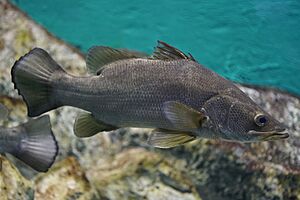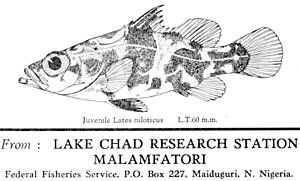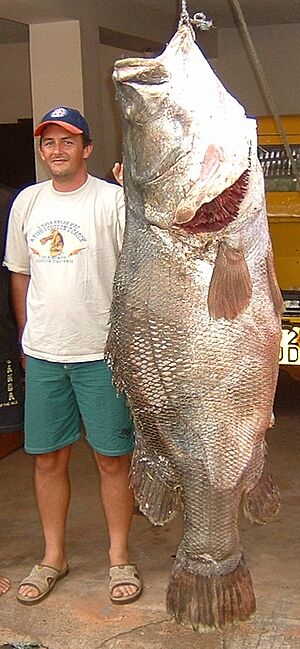Nile perch facts for kids
Quick facts for kids Nile perch |
|
|---|---|
 |
|
| Lates niloticus | |
| Conservation status | |
| Scientific classification | |
| Synonyms | |
|
The Nile perch (Lates niloticus) is a very large freshwater fish. It's also known by names like African snook or Goliath perch. This fish lives in many rivers and lakes across Africa. You can find it in the Congo, Nile, and Niger rivers. It also lives in lakes like Lake Chad and Lake Turkana. The Nile perch is very important for food and business in East Africa.
Contents
About the Nile Perch
The Nile perch is silver with a hint of blue. It has cool dark eyes with a bright yellow ring around them. This fish is one of the biggest freshwater fish in the world! It can grow up to almost 2 m (6 ft 7 in) (about 6.5 feet) long. It can weigh as much as 200 kg (440 lb) (about 440 pounds). That's like a small car!
Adult Nile perch live in all parts of a lake where there is enough oxygen. Young Nile perch stay in shallow areas near the shore. The Nile perch is a fierce predator, meaning it hunts other animals for food. It eats other fish (even its own kind), crustaceans (like crabs), molluscs (like snails), and insects. Young Nile perch also eat tiny water creatures called zooplankton. Nile perch often swim in groups, called schools, to protect themselves from bigger predators.
An Invasive Species
Nile perch have been moved to many other lakes in Africa. This includes Lake Victoria and the man-made Lake Nasser. When a species is moved to a new place and causes harm, it's called an invasive species. The World Conservation Union says the Nile perch is one of the world's 100 worst invasive species.
In Australia, it is against the law to have a living Nile perch. This is because it could compete with the native barramundi fish. The barramundi is similar but grows to 1.5 m (4 ft 11 in), while the Nile perch can grow to 2.0 m (6 ft 7 in).
The Nile perch is very important for fishing. People catch it for food and for sport. It is also raised in fish farms, which is called aquaculture.
Nile Perch in Lake Victoria
The Nile perch was brought to Lake Victoria in East Africa in the 1950s. This is a famous example of how new species can harm an ecosystem.
Since its introduction, people have fished the Nile perch for business. In 2003, sales of Nile perch to Europe were worth 169 million euros. Fishing for sport in Uganda and Tanzania also brought in money from tourism.
However, bringing the Nile perch to Lake Victoria caused big problems for the environment. It led to many native species becoming extinct or nearly extinct. The Nile perch first ate the native cichlid fish. But as those fish became rare, the perch started eating small shrimp and minnows.
The changes to the lake also affected the people living nearby. Many people lost their traditional fishing jobs. They had to find new ways to make money or even move away. At first, the strong nets needed to catch adult Nile perch had to be bought from other countries, which was expensive.
The Nile perch also caused problems on the land around the lake. Native cichlid fish were usually dried in the sun. But Nile perch have a lot of fat, so they need to be smoked to keep them from spoiling. This meant people needed more wood for fires. This led to more deforestation, where forests are cut down, causing soil erosion and desertification.
A movie called Darwin's Nightmare (made in 2004) talks about the problems caused by the Nile perch. It shows how goods are flown into Africa, and then Nile perch are flown out.
The introduction of the Nile perch has greatly changed the food web in Lake Victoria. The lake's ecosystem is now finding a new balance. But it will likely never return to how it was before.
Threats to the Nile Perch
Even though the Nile perch is a successful invasive species, it faces its own dangers. Because it is such a large fish, it can be overfished. Using illegal fishing tools is also a threat. Another problem is the spread of invasive water hyacinths plants. If there aren't enough smaller fish for the Nile perch to eat, it can also become smaller and more vulnerable to predators like crocodiles.
Export
In 2021, a group of fish businesses in Uganda asked their government to stop people from eating Nile perch locally. They wanted to save more fish for export to other countries.
Nile Perch in Ancient Religion
Nile perch were important in the worship of an ancient Egyptian goddess named Neith. Because of this, Nile perch were sometimes mummified. Thousands of mummified perch were found near a temple for Neith in a place called Esna. Mummified perch and statues of perch have also been found in other places linked to Neith.
See also
- Nile tilapia — a similar-named but different fish that is much smaller and mostly feeds on plant matter




